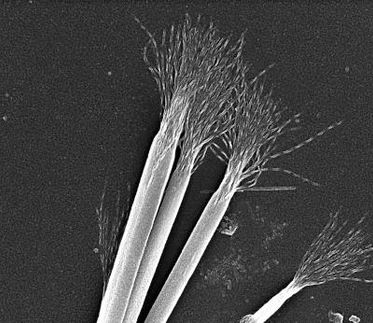Electrostatic force takes charge in bioinspired polymers
Advertisement
Researchers at the University of Illinois and the University of Massachusetts, Amherst have taken the first steps toward gaining control over the self-assembly of synthetic materials in the same way that biology forms natural polymers. This advance could prove useful in designing new bioinspired, smart materials for applications ranging from drug delivery to sensing to remediation of environmental contaminants.
Proteins, which are natural polymers, use amino acid building blocks to link together long molecular chains. The specific location of these building blocks, called monomers, within these chains creates sequences that dictate a polymer's structure and function. The researchers describe how to utilize the concept of monomer sequencing to control polymer structure and function by taking advantage of a property present in both natural and synthetic polymers - electrostatic charge.
"Proteins encode information through a precise sequence of monomers. However, this precise control over sequence is much harder to control in synthetic polymers, so there has been a limit to the quality and amount of information that can be stored," said Charles Sing , a professor of chemical and biomolecular engineering at Illinois and a study co-author. "Instead, we can control the charge placement along the synthetic polymer chains to drive self-assembly processes."
"Our study focuses on a class of polymers, called coacervates, that separate like oil and water and form a gel-like substance," said Sarah Perry, a study co-author and University of Massachusetts, Amherst chemical engineering professor, as well as an Illinois alumna.
Through a series of experiments and computer simulations, the researchers found that the properties of the resulting charged gels can be tuned by changing the sequence of charges along the polymer chain.
"Manufacturers commonly use coacervates in cosmetics and food products to encapsulate flavors and additives, and as a way of controlling the 'feel' of the product," Sing said. "The challenge has been if they need to change the texture or the thickness, they would have to change the material being used."
Sing and Perry demonstrate that they can rearrange the structure of the polymer chains by tuning their charge to engineer the desired properties. "This is how biology makes the endless diversity of life with only a small number of molecular building blocks," Perry said. "We envision bringing this bioinspiration concept full circle by using coacervates in biomedical and environmental applications."
The results of this research open a tremendous number of opportunities to expand the diversity of polymers used and the scale of applications, the researchers said. "Currently, we are working with materials on the macro scale - things that we can see and touch," Sing said. "We hope to expand this concept into the realm of nanotechnology, as well."
Original publication
Other news from the department science
These products might interest you
Most read news
More news from our other portals
See the theme worlds for related content
Topic world Synthesis
Chemical synthesis is at the heart of modern chemistry and enables the targeted production of molecules with specific properties. By combining starting materials in defined reaction conditions, chemists can create a wide range of compounds, from simple molecules to complex active ingredients.

Topic world Synthesis
Chemical synthesis is at the heart of modern chemistry and enables the targeted production of molecules with specific properties. By combining starting materials in defined reaction conditions, chemists can create a wide range of compounds, from simple molecules to complex active ingredients.



































































